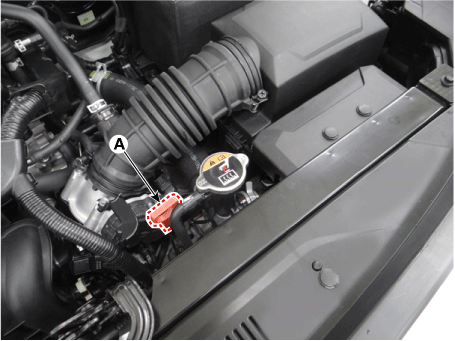Kia Rio: Hydraulic System / Fluid
Repair procedures
Automatic Transaxle
Fluid (ATF) Level Check
| 1. |
Place the vehicle on a level ground.
|
| 2. |
Start the engine to warm up the ATF.
|
| 3. |
Check by using KDS/GDS that the temperature of the ATF is between 70°C
and 80°C (158 - 176°F).
|
| 4. |
Move the shift lever slowly from "P" to "D", then back to "P". Repeat
this sequence a total of two times and then move the shift lever to "N"
range.
|
| 5. |
Remove the oil level gauge (A).

|
| 6. |
Check that the fluid level is in the "HOT" mark on the oil level gauge.
If fluid level is low, add automatic transaxle fluid until the level reaches
the "HOT" mark.
|
Recommended : - ATF SP-Ⅲ
·Recommended transaxle fluid : SK ATF SP-III, MICHANG ATF SP-III,
NOCA ATF SP-III
Capacity : 6.8 L (1.8 U.S gal., 7.2 U.S.qt., 5.98 Imp.qt.)
|
|
If the fluid smells as if it is burning, it means that the fluid
has been contaminated by fine particles from the bushes and friction
materials, a transaxle inpection may be necessary.
|
|
| 1. |
Start the engine.
|
The engine should be stopped within one minute after it is started.
If the fluid has all drained out before then, the engine should
be stopped at that point.
|
|
| 2. |
Remove the ATF drain plug (A), allow the fluid to drain out and then
reinstall the drain plug.
|
Tightening torque :
39.2 - 49.0 N·m (4.0 - 5.0 kgf·m, 28.9 - 36.2 lb·ft)
|

|
| 3. |
Refill the ATF through the ATF filler tube after removing the oil level
gauge (A).

|
You should be stop the pouring when if the full volume of fluid
can not be poured. Then start the engine and run it at idle for
1 - 2 minutes in the N or P position. Then pouring the oil after
turning off the engine.
|
|
| 4. |
Drive the vehicle until the fluid temperature rises to 70 - 80°C (158
- 176°F), and then check the fluid level again. The fluid level must be
at the HOT mark.
|
Specifications
Specification
Item
Specification
Type
Normal open
Input voltage
12 V
...
Repair procedures
Removal
1.
Remove the under cover.
(Refer to Engine Mechanical System - "Engine Room Under Cover").
2.
Remove the AT ...
Other information:
Repair procedures
Replacement and air bleeding
Never remove the radiator cap when the engine is hot. Serious scalding
could be caused by hot fluid under high pressure escaping from the radiator.
...
FCA system is designed to monitor the vehicle ahead through radar signals to
warn the driver that a collision is imminent, and if necessary, apply emergency
braking. In certain situations, the radar sensor may not be able to detect the vehicle
ahead. In these cases, FCA system may not operate. ...
 ON/OFF Solenoid Valve (SCSV-A)
ON/OFF Solenoid Valve (SCSV-A) Oil Filter
Oil Filter


